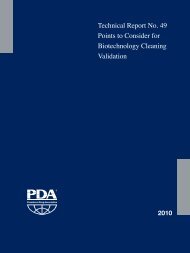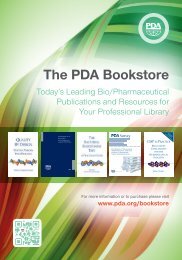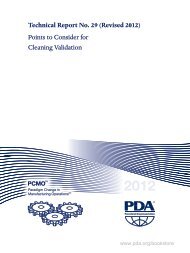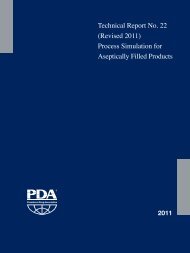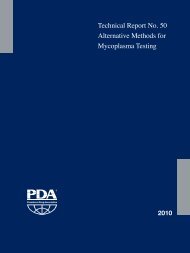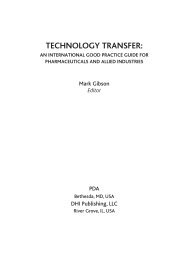Risk-Based Compliance Handbook 1 INTRODUCTION - store.pda.org
Risk-Based Compliance Handbook 1 INTRODUCTION - store.pda.org
Risk-Based Compliance Handbook 1 INTRODUCTION - store.pda.org
You also want an ePaper? Increase the reach of your titles
YUMPU automatically turns print PDFs into web optimized ePapers that Google loves.
Chapter1:Layout 1 29/5/08 10:11 Page 1<br />
<strong>Risk</strong>-<strong>Based</strong> <strong>Compliance</strong> <strong>Handbook</strong><br />
1<br />
<strong>INTRODUCTION</strong><br />
Paracelsus famously stated that all things are poison and not without poison; that<br />
only the dose makes a thing not a poison (“Alle Ding sind Gift und nichts ohn Gift;<br />
alein die Dosis macht das ein Ding kein Gift ist”) (<strong>Handbook</strong> of Pesticide<br />
Toxicology, 2001; www.wikipedia). In this statement he highlighted the benefits and<br />
risks of medicines. This ambivalence still troubles the pharmaceutical industry to<br />
this day. Drugs billed as “blockbusters” have failed to show efficacy after launch,<br />
or have had to be recalled because of safety issues. Over the past decade, 26 major<br />
drugs, with severe side effects, were recalled in the US. These include blockbusters<br />
like Pfizer’s pain-killer Bextra in 2005 (global sales of $1.3 billion prior to recall),<br />
Merck’s pain-killer Vioxx in 2004 ($2.55 billion), Bayer’s heart drug Baycol in 2001<br />
($1 billion), Warner-Lambert’s anti-diabetic Rezulin ($2 billion) and Johnson &<br />
Johnson’s anti-heartburn Propulsid ($1 billion), the last two in 2000<br />
(www.timesofindia). Drugs in Phase III clinical trials have not confirmed the<br />
expected safety and efficacy (www.drugresearcher) and new drug applications have<br />
failed to gain approval from the regulatory authorities despite successful outcomes<br />
of the clinical trials (www.emea.europa; www.oncolink.com). These failures are<br />
tremendously costly, and are a somewhat unexpected result given the many<br />
sophisticated drug development models deployed by the pharmaceutical industry.<br />
Even for successfully marketed drugs there is high risk associated with<br />
planned or unplanned changes to manufacture, analysis or distribution, as changes<br />
may alter the drug, and thus its safety and efficacy. Technical knowledge gained<br />
1<br />
www.<strong>pda</strong>.<strong>org</strong>/book<strong>store</strong>
Chapter1:Layout 1 29/5/08 10:11 Page 2<br />
<strong>Risk</strong>-<strong>Based</strong> <strong>Compliance</strong> <strong>Handbook</strong><br />
2<br />
<strong>Risk</strong>-<strong>Based</strong> <strong>Compliance</strong> <strong>Handbook</strong><br />
Figure 1.1<br />
www.<strong>pda</strong>.<strong>org</strong>/book<strong>store</strong>
Chapter1:Layout 1 29/5/08 10:11 Page 3<br />
<strong>Risk</strong>-<strong>Based</strong> <strong>Compliance</strong> <strong>Handbook</strong><br />
Introduction 3<br />
over the years may not be documented in sufficient detail or may not be readily<br />
available to permit a thorough scientific appraisal of a change. The issue of same<br />
or similar becomes a hot debate (far from resolution) with bio(techno)logical drug<br />
products (www.bioprocessintl.com).<br />
These few examples already help in illustrating the importance for<br />
appropriate and adequate benefit/risk management processes and methodologies<br />
that cover the entire drug lifecycle (see Figure 1.1).<br />
A literature review reveals a plethora of material on specific and particular<br />
aspects of risk management. However, no current publication addresses the entire<br />
drug lifecycle from a benefit/risk perspective. This book aims to provide the<br />
reader with an overview of the available and typically applied methodologies for<br />
risk management, always viewed from a compliance (with the applicable<br />
regulations for health care products, in particular pharmaceutical drug products)<br />
perspective. The information is based on current regulatory guidance, personal<br />
communication with industry, health care associations and regulatory agency<br />
representatives, and selective literature reviews. The result is a compilation of<br />
industry best practices and current trends in benefit/risk management. By relating<br />
these methods and processes to the drug lifecycle and by addressing persistent<br />
industry issues, gaps and shortcomings of the currently available toolbox for<br />
benefit/risk management will become more apparent and easier to detect.<br />
Although the term “risk management” is more prevalent than “benefit/risk<br />
management”, in the end it is always a matter of weighing up the benefits against<br />
the risk — just as Paracelsus pointed out some 500 years ago. What has really<br />
changed since are, of course, the requirements for compliance with the applicable<br />
regulations. The applicable regulations are generally referred to as good practices:<br />
good clinical practice (GCP), good laboratory practice (GLP), good manufacturing<br />
practice (GMP), good distribution practice (GDP) and good pharmacovigilance<br />
practice (GPhVP) (www.mhra.gov.uk). <strong>Compliance</strong> is not something absolute or<br />
precisely defined. On the contrary, it is dependent upon circumstances and<br />
interpretation, and thus always the result of a benefit/risk analysis.<br />
Why this book and why now A great number of training courses are offered<br />
on the subject of risk management, and more importantly on the new paradigm of<br />
a risk-based approach to regulatory compliance. This concept will be described<br />
and discussed in much detail later in this book. There are a large number of articles<br />
in publications targeting the healthcare industry covering risk management related<br />
topics. Despite of all these activities and all the information available, large parts<br />
of the healthcare industry are either unaware, reluctant to embrace or confused as<br />
to the best approach for adopting and implementing these concepts. The problem,<br />
it seems, is in part information overload, and in part missing the context with<br />
www.<strong>pda</strong>.<strong>org</strong>/book<strong>store</strong>
Chapter1:Layout 1 29/5/08 10:11 Page 4<br />
<strong>Risk</strong>-<strong>Based</strong> <strong>Compliance</strong> <strong>Handbook</strong><br />
4<br />
<strong>Risk</strong>-<strong>Based</strong> <strong>Compliance</strong> <strong>Handbook</strong><br />
regards to the drug lifecycle. Therefore, the authors deem it an appropriate time to<br />
present the discerning reader with this publication.<br />
This book does not describe new methods or processes; what it does is to<br />
present an overview and a critical discussion of these in relation to the drug<br />
lifecycle, with the constant aim of achieving compliance. For those familiar with<br />
the healthcare industry it is a known fact that the goal of achieving compliance is<br />
in permanent conflict with the need for marketing in the shortest possible time and<br />
producing at the lowest possible cost. To enable management to make the right<br />
decisions at the right time it is not only essential to have the appropriate processes<br />
and methodologies in place, but also to be in a position to extract data and<br />
information from these that can be presented and communicated in an intelligible<br />
and useful manner. As much of the general public, and sometimes even the<br />
regulators, struggle to comprehend the language and terminology of the industry<br />
technical expert, it is of paramount importance to find ways in which to “translate”<br />
technical speak into common English. The technical experts need to deliver the<br />
benefit/risk information in a way that can be understood by both technical and<br />
commercial staff. The best benefit/risk management activity will invariably fail if<br />
communication is compromised.<br />
ICH Q9 QUALITY RISK MANAGEMENT<br />
<strong>Risk</strong> assessment isn’t just a regulatory strategy. It’s a way for human beings to<br />
cope with the world and its uncertainties<br />
(Clinton, 2003)<br />
The sheer importance given to ICH Q9 is expressed by the conversion of the ICH<br />
guidance document into Annex 20 of the European Good Manufacturing Practices<br />
on 14 February 2008 (ec.europa.eu) by the European Commission. The document<br />
had an operational deadline of 1 March 2008, despite the insistence by the<br />
regulators that it is not mandatory. Nonetheless, this addition also required a<br />
revision of the introduction (ec.europa.eu) and an amendment of chapter 1<br />
(ec.europa.eu) “Quality Management” of EudraLex (ec.europa.eu), The Rules<br />
Governing Medicinal Products in the European Union, and inclusion of a<br />
paragraph on quality risk management:<br />
1.5 Quality risk management is a systematic process for the assessment, control,<br />
communication and review of risks to the quality of the medicinal product. It can<br />
be applied both proactively and retrospectively.<br />
1.6 The quality risk management system should ensure that the evaluation of the<br />
risk to quality is based on scientific knowledge, experience with the process and<br />
ultimately links to the protection of the patient the level of effort, formality and<br />
www.<strong>pda</strong>.<strong>org</strong>/book<strong>store</strong>
Chapter1:Layout 1 29/5/08 10:11 Page 5<br />
<strong>Risk</strong>-<strong>Based</strong> <strong>Compliance</strong> <strong>Handbook</strong><br />
Introduction 5<br />
Figure 1.2<br />
documentation of the quality risk management process is commensurate with<br />
the level of risk.<br />
This poses quite a conundrum for industry — whether to adopt and comply, or to<br />
ignore. The following chapters in this book address risk management in the<br />
context of compliance and good business practices, thereby presenting arguments<br />
for and against the adoption of ICH Q9 in all and every instance or circumstance.<br />
ICH Q9 achieves one eminently important goal by defining on a globally<br />
accepted level the elements that make up (quality) risk management (illustrated in<br />
Figure 1.2).<br />
www.<strong>pda</strong>.<strong>org</strong>/book<strong>store</strong>
Chapter1:Layout 1 29/5/08 10:11 Page 6<br />
<strong>Risk</strong>-<strong>Based</strong> <strong>Compliance</strong> <strong>Handbook</strong><br />
6<br />
<strong>Risk</strong>-<strong>Based</strong> <strong>Compliance</strong> <strong>Handbook</strong><br />
Figure 1.3<br />
www.<strong>pda</strong>.<strong>org</strong>/book<strong>store</strong>
Chapter1:Layout 1 29/5/08 10:11 Page 7<br />
<strong>Risk</strong>-<strong>Based</strong> <strong>Compliance</strong> <strong>Handbook</strong><br />
Introduction 7<br />
Too many equate risk assessment with risk management, when clearly this is<br />
not the case. This is now the framework from which process or product specific<br />
flavours of the methodology may be developed. ICH Q9 standardises where all<br />
others (e.g., ISO (www.iso.<strong>org</strong>)) have failed. Although the document lists in Annex<br />
I several risk management methodologies, these are merely there for reference and<br />
are not aligned to the drug lifecycle.<br />
The flowchart in Figure 1.2 can be expanded to allow for reduced<br />
documentation effort for certain risks. For example, going for a walk when rain is<br />
forecast may mean getting wet. That can be an acceptable risk and does not require<br />
a lengthy risk assessment. The flowchart illustrated in Figure 1.3 contains all these<br />
steps.<br />
TERMINOLOGY<br />
As not all readers may be fully acquainted with the terminology used in risk<br />
management, some definitions are given here, taken from ISO 14971 (www.iso.<strong>org</strong>)<br />
and ICH Q9 (www.ich.<strong>org</strong>).<br />
Harm<br />
Hazard<br />
<strong>Risk</strong><br />
Residual risk<br />
<strong>Risk</strong> analysis<br />
<strong>Risk</strong> assessment<br />
Physical injury and/or damage to the health of people (including<br />
the damage that can occur from loss of product quality, or<br />
availability) or damage to property or the environment.<br />
A possible source of harm.<br />
A combination of the probability of occurrence of harm and the<br />
severity of that harm. This has three primary components — a<br />
hazard, the probability of the hazard occurring (likelihood) and<br />
the potential impact of that hazard (severity).<br />
<strong>Risk</strong>s remaining after protective measures have been taken.<br />
The estimation of the risk associated with the identified<br />
hazards.<br />
A systematic process of <strong>org</strong>anising information to support a<br />
risk decision to be made within a risk management process.<br />
This consists of identifying (risk analysis), estimating and<br />
evaluating (risk evaluation) the nature and severity emanating<br />
from a risk.<br />
www.<strong>pda</strong>.<strong>org</strong>/book<strong>store</strong>
Chapter1:Layout 1 29/5/08 10:11 Page 8<br />
<strong>Risk</strong>-<strong>Based</strong> <strong>Compliance</strong> <strong>Handbook</strong><br />
8<br />
<strong>Risk</strong>-<strong>Based</strong> <strong>Compliance</strong> <strong>Handbook</strong><br />
Figure 1.4<br />
www.<strong>pda</strong>.<strong>org</strong>/book<strong>store</strong>
Chapter1:Layout 1 29/5/08 10:11 Page 9<br />
<strong>Risk</strong>-<strong>Based</strong> <strong>Compliance</strong> <strong>Handbook</strong><br />
Introduction 9<br />
<strong>Risk</strong> management The systematic application of quality management policies,<br />
procedures, and practices to the tasks of assessing,<br />
controlling, communicating and reviewing risk. The overall<br />
and continuing process of minimising risks throughout a<br />
process, product, project or system’s life cycle to optimise its<br />
benefit risk balance.<br />
<strong>Risk</strong><br />
communication<br />
<strong>Risk</strong> control<br />
The sharing of information about risk and risk management<br />
between the decision maker and other stakeholders.<br />
The process through which decisions are reached and<br />
implemented for reducing risks to, or maintaining risks within,<br />
specified limits.<br />
These steps and the associated risk management phases are shown in Figure 1.4.<br />
<strong>Risk</strong>s are often grouped by their impact on a particular aspect of the<br />
industrial environment as shown in the following example. Entries may either<br />
cause a risk to product quality, for example, and thus to the patient, or they may<br />
themselves be at risk.<br />
• Healthcare compliance risks, e.g.,<br />
— finished pharmaceutical product quality<br />
— quality control laboratory analysis results<br />
— patients and consumers safety.<br />
• Personnel risks, e.g.,<br />
— safety<br />
— skills<br />
— health<br />
— training.<br />
• Methodology risks, e.g.,<br />
— manufacturing processes<br />
www.<strong>pda</strong>.<strong>org</strong>/book<strong>store</strong>
Chapter1:Layout 1 29/5/08 10:11 Page 10<br />
<strong>Risk</strong>-<strong>Based</strong> <strong>Compliance</strong> <strong>Handbook</strong><br />
10<br />
<strong>Risk</strong>-<strong>Based</strong> <strong>Compliance</strong> <strong>Handbook</strong><br />
— cleaning processes<br />
— packaging.<br />
• Environmental risks, e.g.,<br />
— heating, ventilation, air conditioning (HVAC)<br />
— environmental protection<br />
— temperature<br />
— humidity<br />
— energy.<br />
• Raw materials risks, e.g.,<br />
— specifications<br />
— use<br />
— composition<br />
— suppliers<br />
— delayed release.<br />
• Machinery risks, e.g.,<br />
— calibration<br />
— maintenance<br />
— productivity.<br />
• Business risks, e.g.,<br />
— corporate reputation<br />
— project execution risks<br />
— brand recognition<br />
www.<strong>pda</strong>.<strong>org</strong>/book<strong>store</strong>
Chapter1:Layout 1 29/5/08 10:11 Page 11<br />
<strong>Risk</strong>-<strong>Based</strong> <strong>Compliance</strong> <strong>Handbook</strong><br />
— integrity<br />
— cost.<br />
Introduction 11<br />
Companies will look beyond compliance risk as there is no sense in having a<br />
compliant process that causes an unacceptable risk to the environment or the<br />
operator.<br />
RISK QUANTIFICATION<br />
Not every risk can be quantified, as in the case where there is no quantitative<br />
methodology available (see Chapter 7 on R&D) or data cannot be quantified, and<br />
it is then acceptable to have qualitative assessments performed. <strong>Risk</strong> quantification<br />
should be kept simple, as almost invariably only high risk issues will be addressed,<br />
given limitations on resources. Table 1.1 provides an overview over several<br />
possible ways to quantify risks.<br />
PROBABILITY OF OCCURRENCE OF HARM<br />
As risk is the combination of the probability of occurrence of harm and the<br />
severity of that harm, the ways this can be expressed, or put into values has to be<br />
addressed. (Some publications use the term harm, others the term hazard, ICH Q9<br />
uses them interchangeably.)<br />
It is not unusual to find risk management teams spending more time arguing<br />
on the “precise” quantification of a specific risk than actually managing the risk.<br />
Equally taxing can be the determination of the likelihood of occurrence. Listed<br />
below are examples for classifying and determining probability.<br />
• Low or 1: improbable — the probability of the risk is perceived to be unlikely.<br />
• Medium or 2: occasional —the probability of the risk is perceived to be likely.<br />
• High or 3: frequent — the probability of the risk is perceived to be highly<br />
likely.<br />
Or<br />
• Very common: ≥1 in 10<br />
• Common: >1 in 100 and
Chapter1:Layout 1 29/5/08 10:11 Page 12<br />
<strong>Risk</strong>-<strong>Based</strong> <strong>Compliance</strong> <strong>Handbook</strong><br />
12<br />
<strong>Risk</strong>-<strong>Based</strong> <strong>Compliance</strong> <strong>Handbook</strong><br />
Table 1.1<br />
www.<strong>pda</strong>.<strong>org</strong>/book<strong>store</strong>
Chapter1:Layout 1 29/5/08 10:11 Page 13<br />
<strong>Risk</strong>-<strong>Based</strong> <strong>Compliance</strong> <strong>Handbook</strong><br />
Introduction 13<br />
Table 1.2<br />
MIL-STD 882D ISO 14971:2000 FDA Guidance<br />
Catastrophic Catastrophic Major<br />
Serious<br />
Major<br />
Critical Critical Major<br />
Marginal Marginal Moderate<br />
Negligible Negligible Minor<br />
• Uncommon: ≥1 in 1,000 and X > 10 –2 )<br />
• Occasional: likely to occur sometime in the life of the system (10 –2 > X > 10 –2 )<br />
• Remote: unlikely but possible to occur in the life of the system (10 –3 > X ><br />
10 –6 )<br />
• Improbable: so unlikely, it can be assumed occurrence may not be<br />
experienced (X < 10 –6 )<br />
Note: ISO 14971:20079 also defines a probability level of “incredible”, which<br />
seems to obsolete itself.<br />
HAZARD (HARM) SEVERITY<br />
The next step in the risk management process is determining the severity of the<br />
impact. Severity is a measure of the possible consequences of a hazard. Severity<br />
levels from three different sources (www.ehcca.com) are compared in Table 1.2.<br />
www.<strong>pda</strong>.<strong>org</strong>/book<strong>store</strong>
Chapter1:Layout 1 29/5/08 10:11 Page 14<br />
<strong>Risk</strong>-<strong>Based</strong> <strong>Compliance</strong> <strong>Handbook</strong><br />
14<br />
<strong>Risk</strong>-<strong>Based</strong> <strong>Compliance</strong> <strong>Handbook</strong><br />
Figure 1.5<br />
www.<strong>pda</strong>.<strong>org</strong>/book<strong>store</strong>
Chapter1:Layout 1 29/5/08 10:11 Page 15<br />
<strong>Risk</strong>-<strong>Based</strong> <strong>Compliance</strong> <strong>Handbook</strong><br />
Another possibility is to classify severity as follows.<br />
Introduction 15<br />
• Low or 1: expected to have a minor negative impact — the damage would not<br />
be expected to have a long term detrimental effect.<br />
• Medium or 2: expected to have a moderate impact — the impact could be<br />
expected to have short- to medium-term detrimental effects.<br />
• High or 3: expected to have a very significant negative impact — the impact<br />
could be expected to have significant long-term effects and potentially<br />
catastrophic short-term effects.<br />
HAZARD DETECTABILITY<br />
Detectability is the ability to discover or determine the existence, presence, or fact<br />
of a hazard. Processes that improve the detectability of hazards and quality risks<br />
might also be used as part of a risk control strategy. The probability of a risk being<br />
detected can be estimated as follows.<br />
• Low or 1: detection of the fault condition is perceived to be unlikely.<br />
• Medium or 2: detection of the fault condition is perceived to be reasonably<br />
likely.<br />
• High or 3: detection of the fault condition is perceived to be highly likely.<br />
RISK EVALUATION<br />
A variety of methods may be used to combine the likelihood estimate with the<br />
severity rating and the detectability. These may be multiplied together to obtain a<br />
numeric estimate of risk. The risk grade, also sometimes called a risk priority<br />
number (RPN), is calculated as:<br />
RPN = probability of occurrence × severity of impact × detectability<br />
Depending on the values selected during the hazard identification process, this<br />
will yield a specific number or a qualitative description (e.g., medium). Figures<br />
1.5 and 1.6 give an example for the visualisation of this concept.<br />
The risk classification from Figure 1.5 is correlated with the detectability for<br />
yielding a risk priority number, which is then used to determine whether risk<br />
reduction and/or risk mitigation is needed.<br />
www.<strong>pda</strong>.<strong>org</strong>/book<strong>store</strong>
Chapter1:Layout 1 29/5/08 10:11 Page 16<br />
<strong>Risk</strong>-<strong>Based</strong> <strong>Compliance</strong> <strong>Handbook</strong><br />
16<br />
<strong>Risk</strong>-<strong>Based</strong> <strong>Compliance</strong> <strong>Handbook</strong><br />
Figure 1.6<br />
www.<strong>pda</strong>.<strong>org</strong>/book<strong>store</strong>
Chapter1:Layout 1 29/5/08 10:11 Page 17<br />
<strong>Risk</strong>-<strong>Based</strong> <strong>Compliance</strong> <strong>Handbook</strong><br />
Introduction 17<br />
Another aspect of addressing risk significance is in the business planning context,<br />
where in the context of risk, the significance is described as a function of time<br />
(www.symantec.com).<br />
• Long-term (years) — risks resulting from global events, and laws and<br />
legislation.<br />
• Medium-term (months) — risks resulting from market forces.<br />
• Short-term (days) — risks resulting from interactions with third parties (e.g.,<br />
customers).<br />
• Operational (hours or minutes) — risks arising from the normal operational<br />
environment.<br />
In the healthcare industry the long-term risks are likely to be the most critical,<br />
having the highest potential to cause serious damage.<br />
RISK MITIGATION AND RISK REDUCTION<br />
Each identified hazard needs to be assessed as to whether the associated risk is<br />
negligible, acceptable or unacceptable. For unacceptable risks, the mitigation<br />
strategy should define the corrective, correction and preventive actions to help<br />
modify the risk levels and bring it down to an acceptable risk level.<br />
• <strong>Risk</strong> mitigation — the focus is on the reduction of the severity of impact of<br />
harm.<br />
• <strong>Risk</strong> reduction — the focus is on the reduction of probability of occurrence and<br />
detectability of harm. Measures are then implemented to minimise the risk.<br />
• Corrective action (www.iso.<strong>org</strong>) — action taken to eliminate the causes of an<br />
existing non-conformity, defect or other undesirable situation in order to<br />
prevent recurrence.<br />
• Correction action — action taken to repair, rework, or adjust and relate to the<br />
disposition of an existing nonconformity.<br />
• Preventive action — action taken to eliminate the cause of a potential nonconformity,<br />
defect, or other undesirable situation in order to prevent<br />
occurrence.<br />
www.<strong>pda</strong>.<strong>org</strong>/book<strong>store</strong>
Chapter1:Layout 1 29/5/08 10:11 Page 18<br />
<strong>Risk</strong>-<strong>Based</strong> <strong>Compliance</strong> <strong>Handbook</strong><br />
18<br />
<strong>Risk</strong>-<strong>Based</strong> <strong>Compliance</strong> <strong>Handbook</strong><br />
Table 1.3<br />
Ease of Efficacy of Cheapness of Overall<br />
implementation operation implementation<br />
Detection/ Poor Good Poor Poor<br />
Prevention<br />
Fixing Average Average Average Average<br />
Management Good Poor Good Good<br />
<strong>Risk</strong>s in the areas labelled L for low in Figure 1.6 are generally judged as broadly<br />
acceptable to all parties and do not require risk reduction. Those labelled M<br />
represent an area of undesirable risks. However, these can be tolerable if risk<br />
reduction is impracticable or if its cost is disproportionate compared to the<br />
improvement gained. In this zone, the balance of cost versus benefit is the key. A<br />
written rationale justifying the decision is needed and consideration given to<br />
increased monitoring to ensure any occurrence of the failure is detected. Finally,<br />
those areas assessed as H represent an area of high risk. These risks are generally<br />
judged as intolerable so that risk reduction measures must be implemented.<br />
Once any risk mitigation or reduction measures have been put in place, the<br />
assessment has to be repeated in order to verify that the outcome is acceptable as<br />
assumed.<br />
The relative values of the control measures, can take into consideration, for<br />
example (www.symantec.com):<br />
• ease of implementation<br />
• efficacy of operation<br />
• cheapness of implementation.<br />
Table 1.3 provides an example assessment.<br />
www.<strong>pda</strong>.<strong>org</strong>/book<strong>store</strong>
Chapter1:Layout 1 29/5/08 10:11 Page 19<br />
<strong>Risk</strong>-<strong>Based</strong> <strong>Compliance</strong> <strong>Handbook</strong><br />
RISK ACCEPTANCE AND RISK REVIEW<br />
Introduction 19<br />
Usually quality assurance is required to verify that the measures put in place are<br />
in accordance with the internal quality system, rules and regulations, and that they<br />
have achieved their purpose. In addition, the involved parties need to verify and<br />
confirm the effectiveness of the risk management process.<br />
The business environment is rarely static for long, and the applicable<br />
regulatory framework is also subject to change. Therefore, the necessity,<br />
frequency and methodology for the review of past risk assessments should be<br />
detailed in an internal document, such as a standard operating procedure (SOP).<br />
RISK COMMUNICATION<br />
<strong>Risk</strong> communication is an essential activity in ensuring an effective risk management<br />
process throughout the entire product lifecycle. It is one way of evaluating the<br />
effectiveness of the risk management. Therefore, it is essential to ensure that<br />
everyone appreciates the importance of risk management and risk assessments and<br />
that all have a good and comprehensive understanding of the process.<br />
A company should define a suitable program for communication of risk<br />
messages to the target audience and ensure that these have been received and<br />
understood. Management has to encourage all staff to adopt risk reduction<br />
behaviour. The program should define who, how, why, and how often messages<br />
need be delivered to the intended targets, including regulatory authorities.<br />
Communication need not be carried out for each and every risk acceptance.<br />
ICH Q8, Q9 AND Q10<br />
<strong>Risk</strong> management as described in ICH Q9 (www.ich.<strong>org</strong>) is a concept that can be<br />
developed as a stand-alone item. However, the full benefit of the new approaches<br />
to pharmaceutical quality will be best obtained by implementing the concepts in<br />
ICH Q8 Pharmaceutical Development, ICH Q9 Quality <strong>Risk</strong> Management and<br />
ICH Q10 Pharmaceutical Quality System together (PDA, 2008).<br />
Whereas the ICH Q8 and Q9 guidelines have been finalised and adopted by<br />
member states, ICH Q10 is currently at step 2 of the ICH review and adoption<br />
process.<br />
The ICH Q8 guideline is intended to provide guidance on the contents of<br />
Section 3.2.P.2 (Pharmaceutical Development) for drug products as defined in the<br />
www.<strong>pda</strong>.<strong>org</strong>/book<strong>store</strong>
Chapter1:Layout 1 29/5/08 10:11 Page 20<br />
<strong>Risk</strong>-<strong>Based</strong> <strong>Compliance</strong> <strong>Handbook</strong><br />
20<br />
<strong>Risk</strong>-<strong>Based</strong> <strong>Compliance</strong> <strong>Handbook</strong><br />
Figure 1.7<br />
www.<strong>pda</strong>.<strong>org</strong>/book<strong>store</strong>
Chapter1:Layout 1 29/5/08 10:11 Page 21<br />
<strong>Risk</strong>-<strong>Based</strong> <strong>Compliance</strong> <strong>Handbook</strong><br />
Introduction 21<br />
scope of Module 3 of the Common Technical Document. The guideline does not<br />
apply to contents of submissions for drug products during the clinical research<br />
stages of drug development. However the principles in this guideline should be<br />
considered during these stages. This guideline might also be appropriate for other<br />
types of products, and to determine its applicability for a particular type of<br />
product, applicants should consult with the appropriate regulatory authorities.<br />
An annex to ICH Q8 was released on 1 November 2007 for consultation. This<br />
provides further clarification of key concepts outlined in the core guideline. In<br />
addition, this annex describes the principles of quality by design (QbD). The<br />
annex is not intended to establish new standards. However, it shows how concepts<br />
and tools (e.g., design space) outlined in the parent Q8 document could be put into<br />
practice by the applicant for all dosage forms. Where a company chooses to apply<br />
quality by design and quality risk management (Q9: Quality <strong>Risk</strong> Management),<br />
linked to an appropriate pharmaceutical quality system, then opportunities arise to<br />
enhance science- and risk-based regulatory approaches (see Q10: Pharmaceutical<br />
Quality System).<br />
Whereas the ICH Q9 guideline provides principles and examples of tools for<br />
quality risk management that can be applied to all aspects of pharmaceutical<br />
quality, including development, manufacturing, distribution, and the inspection<br />
and submission/review processes throughout the lifecycle of drug substances and<br />
drug (medicinal) products, biological and biotechnological products, including the<br />
use of raw materials, solvents, excipients, packaging and labeling materials, the<br />
ICH Q8 guideline is much more limited in scope.<br />
The ICH Q10 Pharmaceutical Quality System guideline, which was released<br />
for consultation under Step 2 of the ICH process on 9 May 2007, applies to<br />
pharmaceutical drug substances and drug products, including biotechnology and<br />
biological products, throughout the product lifecycle. The elements of Q10 should<br />
be applied in a manner appropriate and proportionate to each of the product lifecycle<br />
stages, recognising the differences among, and the different goals of, each stage.<br />
Despite the differences in scope and applicability between ICH Q8 and the<br />
Q9 and Q10 guidelines, the regulators emphasise the integration of these three<br />
guidelines into one integrated concept (shown in Figure 1.7) (as presented at<br />
several conferences by various regulatory agency members who helped developed<br />
the guidelines).<br />
It becomes immediately apparent that these guidelines go beyond what is<br />
required for GMP compliance. This should bring with it a number of benefits for<br />
industry and of course the patients. As with all new and generally untested<br />
concepts it will take a while for industry to accept, adopt and apply them.<br />
www.<strong>pda</strong>.<strong>org</strong>/book<strong>store</strong>
Chapter1:Layout 1 29/5/08 10:11 Page 22<br />
<strong>Risk</strong>-<strong>Based</strong> <strong>Compliance</strong> <strong>Handbook</strong><br />
22<br />
<strong>Risk</strong>-<strong>Based</strong> <strong>Compliance</strong> <strong>Handbook</strong><br />
This integrated approach calls for innovation in science and the way<br />
compliance is achieved, based on benefit/risk assessments. These are good<br />
intentions, and provided both the industry and the authorities have equally strong<br />
scientific and compliance knowledge this could indeed fundamentally change the<br />
healthcare industry.<br />
Let us now take you on a journey following the drug lifecycle, where we<br />
address the many facets of benefit and risk from the perspective of all those involved<br />
in the process, all of whom work towards one common goal: to deliver a safe and<br />
efficacious product to the patients in compliance with the healthcare regulations.<br />
REFERENCES<br />
Cap Uldriks, CDRH, Using <strong>Risk</strong> Management to Defend Reporting Decisions to<br />
the FDA, www.ehcca.com/presentations/devicecongress2/uldriks_a.pdf<br />
<strong>Handbook</strong> of Pesticide Toxicology (2001) Academic Press<br />
http://ec.europa.eu/enterprise/pharmaceuticals/eudralex/<br />
http://en.wikipedia.<strong>org</strong>/wiki/Paracelsus<br />
http://www.bioprocessintl.com/popups/articles.aspid=30120074<br />
http://www.bioprocessintl.com/popups/articles.aspid=50120073<br />
http://ec.europa.eu/enterprise/pharmaceuticals/eudralex/vol-4/pdfsen/2008_02_12_gmp_annex20.pdf<br />
http://ec.europa.eu/enterprise/pharmaceuticals/eudralex/vol-4/pdfsen/2008_02_12_introduction_gmp.pdf<br />
http://ec.europa.eu/enterprise/pharmaceuticals/eudralex/vol-4/pdfsen/2008_02_14_gmp-part1-chapter1_q9.pdf<br />
http://www.drugresearcher.com/news/ng.aspn=74564-novo-nordisk-genentechstroke-blood-clot-novoseven<br />
http://www.emea.europa.eu/htms/human/opinion/opinion.htm<br />
http://www.oncolink.com/library/article.cfmc=2&s=76&id=775<br />
www.<strong>pda</strong>.<strong>org</strong>/book<strong>store</strong>
Chapter1:Layout 1 29/5/08 10:11 Page 23<br />
<strong>Risk</strong>-<strong>Based</strong> <strong>Compliance</strong> <strong>Handbook</strong><br />
http://timesofindia.indiatimes.com/India/Drug_majors_reel_as_blockbusters_fail<br />
/articleshow/2205768.cms<br />
ISO 8402, www.iso.<strong>org</strong><br />
PDA Extra Report (2008) QRM & Regulatory Inspections, 28 February, Vol. 2,<br />
No. 2<br />
Standard Practice for System Safety, MIL-STD-882D (2000) Department of<br />
Defense, February 10, Appendix A, Table A-2, page 19,<br />
www.safetycenter.navy.mil/instructions/osh/milstd882d.pdf<br />
Symantec (2006) Integrated IT risk management, www.symantec.com<br />
www.ich.<strong>org</strong><br />
www.iso.<strong>org</strong><br />
www.mhra.gov.uk<br />
Introduction 23<br />
www.<strong>pda</strong>.<strong>org</strong>/book<strong>store</strong>
Chapter1:Layout 1 29/5/08 10:11 Page 24<br />
<strong>Risk</strong>-<strong>Based</strong> <strong>Compliance</strong> <strong>Handbook</strong><br />
www.<strong>pda</strong>.<strong>org</strong>/book<strong>store</strong>



